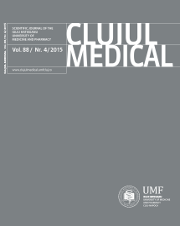Non-alcoholic fatty liver disease severity, central fat mass and adinopectin: a close relationship
DOI:
https://doi.org/10.15386/cjmed-595Keywords:
non-alcoholic fatty liver disease, body composition, central obesity, insulin resistance, adiponectinAbstract
AIM: Non-alcoholic fatty liver disease (NAFLD) is the most common chronic liver disease in the general population. Overweight is a common conditions in patients with NAFLD, and body composition (BC) assessment is useful to evaluate nutritional status and the efficacy of nutritional strategies. A valid tool for assessing BC is dual-energy X-ray absorptiometry (DXA). Adiponectin has been shown to be relevant to the pathogenesis of NAFLD. The aim of this observational study is to define the relationship between the severity of NAFLD, the central fat mass evaluated by DXA, and the circulating levels of adiponectin.
METHODS: The study was carried out in 31 overweight patients. The degree of liver steatosis was evaluated by ultrasound (US) examination. Anthropometric parameters were measured according to standard methods. Fasting glucose and insulin level were used also to calculate insulin resistance (IR), according to the homeostasis model assessment-insulin resistance (HOMA-IR). The enzyme-linked immunosorbent assay technique was performed to dose fasting serum levels of adiponectin.
RESULTS: NAFLD progression was significantly associated with increased central fat (p<0.05). Using DXA, we quantified the regional distribution of adipose tissue and found the expected association between central fat and the US severity of NAFLD. Serum levels of adiponectin, were inversely related to NAFLD progression (p<0.05).
CONCLUSION: BC evaluated by anthropometry and DXA, may be used as indicator of NAFLD severity in overweight patients. The evaluation of BC in clinical practice, can improve the nutritional strategies and follow-up. In the clinical setting adiponectin can represent a potential marker for the staging of NAFLD.
Downloads
Published
How to Cite
Issue
Section
License
The authors are required to transfer the copyright of the published paper to the journal. This is done by agreeing to sign the Copyright Assignment Form. Whenever the case, authors are also required to send permissions to reproduce material (such as illustrations) from the copyright holder.

The papers published in the journal are licensed under a Creative Commons Attribution-NonCommercial-NoDerivatives 4.0 International License.

